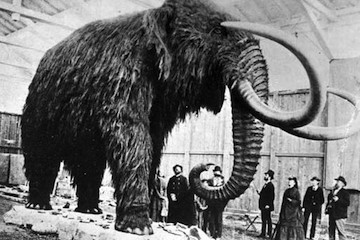West Coast History
Often the bellwether for the nation's social trends, the West Coast has always been the place for a fresh start. From the Gold Rush to Hollywood to the founding of Silicon Valley, life has rarely been dull on the far edge of the country.
Recommended Reading
- Gavan Daws - Shoal of Time: A History of the Hawaiian Islands
- Harry Ritter - Alaska's History: The People, Land, and Events of the North Country (Alaska Pocket Guide)
- Hilary Stewart - Looking at Indian Art of the Northwest Coast
- Daniel Hurewitz - Bohemian Los Angeles: and the Making of Modern Politics
- Iris Chang - The Chinese in America: A Narrative History
- Lillian Faderman and Stuart Timmons - Gay L. A.: A History of Sexual Outlaws, Power Politics, And Lipstick Lesbians
Nature Communications -- "What Killed the Wooly Mammoth?"
For millennia, wooly mammoths roamed the Ice Age steppes of Alaska and Beringia. Glen McDonald of UCLA examines their extinction in a scientific study.
Timeline
- c.12000 B.C. - The first people arrive in what is now Alaska over the Bering Strait (then an isthmus) -- although some sources dispute this claim.
- c.300 - Polynesian settlers arrive in Hawaii and establish villages, astoundingly traveling in small canoes over thousands of miles of open ocean.
- 1769 - A Spanish colonization effort results in the founding of San Diego. San Francisco follows in 1776, and Los Angeles is founded in 1781 by forty-four settlers.
- 1810 - The Pacific Fur Company, owned by John Jacob Astor, establishes Astoria at the mouth of the Colombia River. It is the first permanent U.S. settlement on the Pacific Coast.
- 1843-1849 - The Oregon Trail becomes the route by which up to 300,000 settlers arrive in Oregon from the eastern United States.
- 1849 - The California Gold Rush increases the population and wealth of San Francisco and northern California in legendary fashion.
- 1867 - William Seward is ridiculed by much the American press after spending $7.2 million to purchase the territory of Alaska from Russia.
- 1893 - Queen Lili'uokalani of Hawaii is overthrown by a group of European and American business leaders, against the wishes of most natives. Hawaii is then annexed to the United States in 1898.
- 1914 - Cecil DeMille and Oscar Apfel's The Squaw Man becomes the first feature film to be made in Hollywood.
- 1916 - William Boeing founds the Boeing Airplane Company, taking advantage of Washington's ample supply of spruce trees. Boeing's first passenger flights are made in 1929.
- 1935-1938 - Over 250,000 migrants flee the South (and Oklahoma in particular) for California, and soon pick up the derisive nickname of "Okies".
- 1942 - The Bracero program is created to secure labor in the midst of World War II, and will survive into the 1960s. Over 500,000 Mexicans had been deported during the Great Depression.
- 1964 - Ken Kesey and a band of followers begin their LSD-infused tour of the United States aboard his psychedelically painted bus known as "Furthur". By 1967 hippie culture gains national prominence with the "Summer of Love".
- 1965 - Increased Mexican and Asian immigration is spurred by the US Immigration and Nationality Act of 1965, having a particular effect on the demographics of the West Coast.
- 1975/1976 - Microsoft and Apple are founded one year apart, becoming innovators and rivals in the computer industry.
ERAS:
Pre-Contact - Colonial - Revolutionary - Antebellum - Civil War - Gilded Age - Depression/World War II - Modern
PEOPLE:
American Indian - Anglo/Scottish - Black - Hispanic - Women - Asian - LGBT - Irish - Jewish - Children
